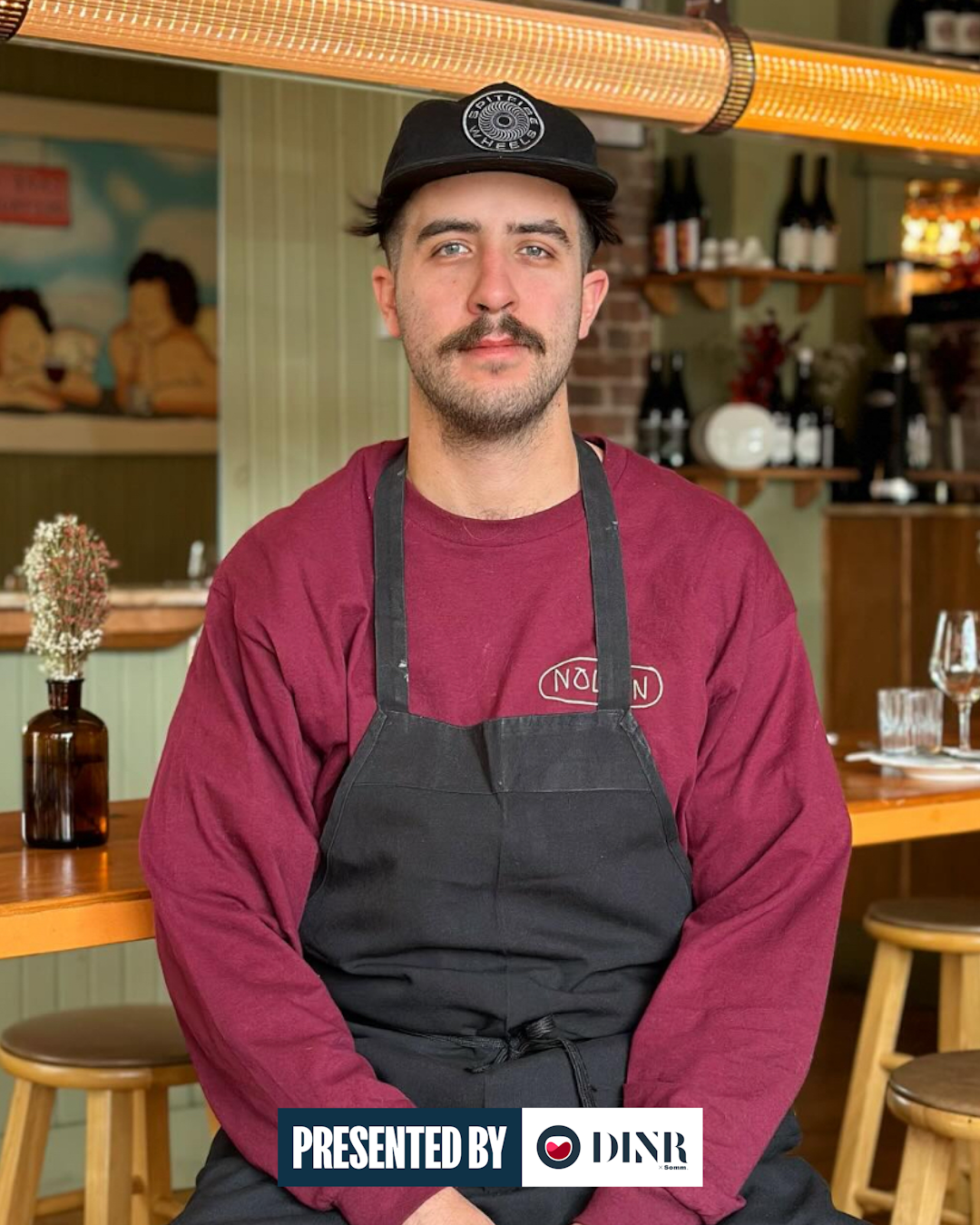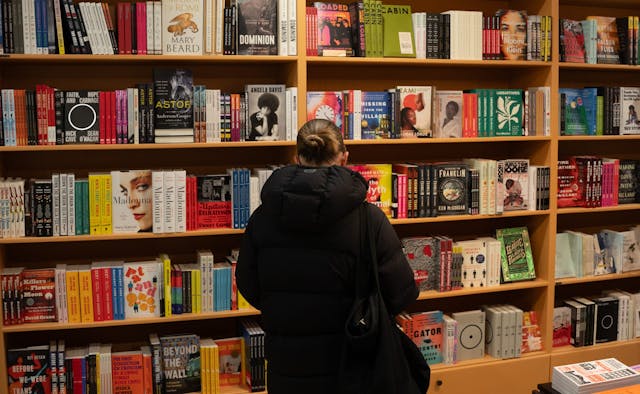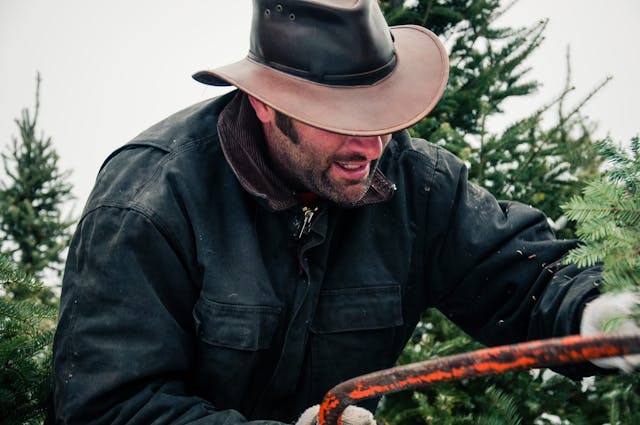The creative process behind the menus of Montreal's chefs
Listening in to Montreal's chefs on where their menu creation begins, and what their philosophies of food are.
 Nolan’s chef Charles Dumais. | Photograph: Julien Betancourt
Nolan’s chef Charles Dumais. | Photograph: Julien BetancourtWhat goes into creating a menu at Montreal's restaurants? Where do the ideas behind their dishes begin and end?
Quebec’s known for having amazing ingredients to work with, so much so that the untrained eye, tongue and hand will have a hard time knowing what to do at the right time of year.
For Montreal’s chefs, it's a juggling act between so many factors, from honoring that cornucopia of ingredients properly to harnessing their own history and skills, satisfying the customers, a restaurant's concept, personal philosophies of food and cooking, and a myriad of other factors.
The process is always going to be different depending on how you ask, but much like asking how someone writes an album or book, or how they logistically solve a problem, the answers will always enlighten.
ALL METHOD, NO MADNESS
"A menu or recipe doesn't come together on a whim. It's thoughtful, tested, discussed, organized, and always open to improvements," says Nolan’s chef Charles Dumais.
The process goes something like this: "When we're crafting a new menu, our focus is on imagining dishes that our customers would love—something distinctive yet accessible, a meal that speaks to our clients," he says.
"Then we consider the season, the temperature, and the availability of local Quebec produce. We maintain constant communication with producers and suppliers to stay updated on freshness. This enables us to create a menu that aligns with the time of year and the preferences of our clients."
I believe that an idea is born out of sensory, visual, and tasting experiences. Before we create a dish, we taste each ingredient, understand their origin, and grasp the product's environment.


Showing the goods, and Nolan’s chef Charles Dumais in his natural environment. | Photograph: Julien Betancourt
Aiming to showcase local vegetables or proteins, complemented by side dishes that enhance the core ingredient without altering their essence, Dumais says the process involves brainstorming ideas, testing them, making adjustments, and refining the final result.
Just as meticulous and strategic as it is instinctual, "I believe that an idea is born out of sensory, visual, and tasting experiences. Before we create a dish, we taste each ingredient, understand their origin, and grasp the product's environment,” Dumais says.
“Going through these stages creates a process triggered by visual memories, smells, and so on. That's where instinct begins and leads us to create a very thought-out plan of transformation.”

For Dumais, it's always important to seek the advice of Nolan's producers and learn about the sensory qualities of ingredients to understand their potential.
By doing proper research, it allows them to use the entirety of the product, avoid waste, and be original.
"For us, this is the best way to operate, maximizing the best possible output for a particular product. Through experimentation, we can optimize the taste, appearance, shape, cooking method, and flavours," he explains.

AND THEN THERE'S THRIVING ON CHAOS
“In a given year in Montreal, there are roughly nine months where the food doesn’t change a lot, albeit with a few exceptions. But then there’s an explosion in the summer where you’ll go from zero to 100. It comes at you so quickly,” says Bistro La Franquette’s chef Louis Deligianis.
That ebb and flow between stability and predictability, and a no-holds-barred period, means that it comes down to how you focus amongst chaos.
If you have a fear, the closer you get to it, the less scary it becomes. To do something that’s never been done, you just have to do it, plain and simple. The most fun nights are the ones you didn’t expect.
“Artichokes, peas, beans, zucchini and zucchini flowers, peppers, tomatoes—not to mention fruit—everything is coming at you with such speed, and you have to slow it down and make it work for you.”
At Franquette, the menus are based on years of honed techniques to the point where everything’s become second nature to the chef. Louis’s far from a chaotic person, but he’s the kind of person that thrives on chaos to create, and in thriving on chaos, he becomes his own rock.
I’m almost more comfortable in the chaos. Service is when I’m humming, that’s my frequency.



Louis in the kitchen. | Photograph: Scott Usheroff / @cravingcurator & @bistrolafranquette
“I’m almost more comfortable in the chaos. Service is when I’m humming, that’s my frequency: Say you’re prepping for tasting menus, and you’ve got 65 covers. The electrical goes out at 3:30pm until 5pm. You’re working in the dark, and you open because the power comes back on. Then you find out a vegan’s coming, and you’ve got to make a whole separate menu for them.”
Sound stressful? Sure. It’s a headspace where adaptation has to become second nature. When pressure it applied, you don’t have a choice—you’re running a small business and need the money—and have to exhibit your own control.
“I need intensity,” he says. “If you have a fear, the closer you get to it, the less scary it becomes. To do something that’s never been done, you just have to do it, plain and simple. The most fun nights are the ones you didn’t expect.”
In many ways, what Louis is saying is reassuring. Creativity can be such a burden when looking at it from the outside, and the only way you can reach the level you want to be at is by putting in the work, the time, the training. Through that, ideas can flow in the most unlikely of places.

That’s how he created one of his favourite dishes:
“I was doing a pop-up, filling in because the chef got COVID. I was told to do whatever I wanted, went into the fridge, found corn, and ran with it.
"I took corn on the cob, took the kernels off and juiced them; the pulp goes into the pot and the cob gets grilled for a roasted stock with parmesan rinds, bacon skins, and burnt onion.
"The juice goes on the heat, monter au beurre until thickened, blanche some corn, slice it off the cob, and burn it; pasta goes down, shallots in, sweated and deglazed with white wine, reduced with stock. More butter, then I add the corn stock, parmesan, a ton of cracked pepper—twirl, twirl, twirl into an oval—until I push the corn onto it so it looks like an ear of corn.
"Then it’s fresh chives, Mimolette cheese, espelette pepper, and a bit of lemon. Done.”

Sometimes just anchovies and butter with some sourdough is all you need.
TASTE, PURE AND SIMPLE
For Theo Lerikos, he’s done his time on the line at Tuck Shop. Having been its chef since it first opened in 2010, after all the years of accolades and attention, he’s come to find that it’s all about honest, good, tasty food that’s consistent.
Menus here are small and balanced, keeping a few staples around like oysters and steak-frites, a pasta course, and generally two meat courses. All delicious, while the kitchen will undoubtedly get creative, it’s less about splashes of sauces or delicate foams, and more about being that reliable place on the corner.
“If you trying to make art—overproduce the look of the food and the technique behind it—it can take away from the taste of it,” the chef says.
Lerikos will have the final say on a menu that moves with the seasons, using ingredients ranging from brief arrivals of seafood from the Newfoundland coast to winter greens from farms outside the city, wild mushrooms from his own farm, or pork from the century-old Beaurivage.
There is, however, a highly collaborative element to the menus at the restaurant.
“I have a meeting with my chef twice a week, and the whole staff once a week in the kitchen, and we talk about where the menus at. I like to pull ideas and get everyone involved; it challenges my cooks to be interested, but it also gives them a sense of ownership of the menu,” he says.
The real question comes down to whether or not it will represent the restaurant—quite simply, is it delicious?
“A lot of cooks want to do very chef-forward things—frozen foie gras shaving, sous-vide this and fermented that—and I say OK, but if you put all these techniques together, it needs to be delicious. Sometimes just anchovies and butter with some sourdough is all you need,” he says.
After years of cooking, Lerikos has come to understand which ingredients go well together, making daily trips to the market and working closely with local vegetable and livestock farmers no matter the season, and it’s now more about highlighting a product.
But that takes time: “From where I opened to where I am now, I have a lot more of an identity in the kitchen with confidence in myself,” he explains. “We’re trying to put less ingredients on the plate, and let things speak for themselves; not to layer things, but let the ingredients be simple.”
“We’re not trying to reinvent the wheel, we’re trying to put out consistent bistro fare and consistency’s important. It’s nice to win awards and get accolades, but it’s more about the customers that leave here satisfied.”
This article was brought to you by DINR. For same-day reservations at some of Montreal's most exclusive restaurants, download the app and reserve today.






![The Best New Restaurants in Montreal [April 2025]](/_next/image?url=https%3A%2F%2Fthemain.ghost.io%2Fcontent%2Fimages%2F2025%2F04%2F021030890026.jpg&w=640&q=75)

